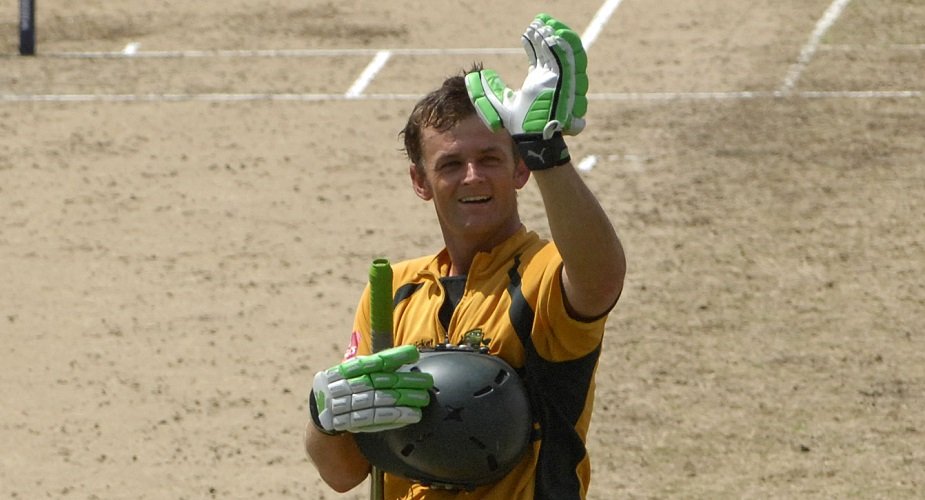Best and Worst: World Cup innovations – From Gilly’s squash ball to the rain pain

From Martin Crowe’s ingenious captaincy to Bob Woolmer’s radio ruse, Calum Trenaman pens down the best and worst World Cup innovations – the moments when teams pushed the boundaries on the biggest stage.
First published in Issue 20 of Wisden Cricket Monthly
THE BEST
The pinch-hitter
Jayasuriya and Kaluwitharana often take the credit for revolutionising the approach of openers in one-day cricket but four years earlier came Mark Greatbatch, the beefy Kiwi who hit 13 sixes in the 1992 tournament, more than double his nearest rival.
Brought in for New Zealand’s third match after an injury to John Wright, Greatbatch swatted Allan Donald and the rest of the South African attack to all parts, hitting nine fours and two sixes in his 60-ball 68. He retained the role for the rest of the tournament as Martin Crowe’s side topped the round-robin table. In the semi-final against Pakistan, Greatbatch hit two sixes before being bowled for 17 by an Aaqib Javid slower ball described by Tony Greig on commentary as “hardly quick enough to knock the bails off”. New Zealand went on to lose a match they should have won but the pinch-hitter was here to stay.
Opening turn
Crowe’s Promethean master-plan for the ’92 tournament also included giving the new ball to Dipak Patel, an off-spinner who hadn’t played an ODI in more than a year prior to the World Cup. The strategy, designed to prevent batsmen clearing the infield during the first 15 overs, proved ingenious as Patel successfully muzzled Australia in New Zealand’s opener and finished the World Cup with an economy rate of 3.10, the best in the tournament.
Gilchrist’s foreign object
When Adam Gilchrist celebrated reaching 100 off just 72 balls in the 2007 World Cup final against Sri Lanka he raised his hand to the camera to show a curious lump in his glove. This was later revealed to be a squash ball, designed to prevent him from rolling the bat in his hands, and therefore encouraging him to play straighter and with the full face of the bat. Sri Lanka Cricket’s secretary Kangadaran Mathivanan described Gilchrist’s use of a foreign object as “unethical” but the following day the MCC released a statement saying the use of the squash ball didn’t contravene any laws or the spirit of the game.
THE WORST
Rain rules the day
The 1992 World Cup saw the birth and swift death of the rain rule. The previous regulations were seen as too heavily favouring the side batting second and so a new rule was drawn up by experts, including Richie Benaud, which meant in a rain-affected contest the target would be proportionate to the lowest scoring overs of the side batting first. Unfortunately, Richie and his pals had a stinker.
A farce played out in South Africa’s semi-final against England at the SCG. The Proteas, having required 22 runs from 13 balls, suddenly found themselves needing the same number of runs from just one delivery as the two maiden overs England which had earlier played out were wiped from the equation after a rain delay. The misconceived rule became an embarrassment the game would rather forget.
Location, Location, Location
The fact the 1996 World Cup was co-hosted – by India, Pakistan and Sri Lanka – wasn’t new as such; India and Pakistan had shared hosting duties nine years earlier. However, the 1996 edition had games played at a total of 26 venues spread across the three countries, which became a logistical nightmare for teams. On top of this, Australia and West India refused to play in Sri Lanka due to security concerns, the result being that Sri Lanka qualified for the quarter-finals before a single ball had been bowled.
Radio ga ga
After observing the use of radios in American sport, South Africa coach Bob Woolmer decided to employ the tactic during the 1999 World Cup. Hansie Cronje and Allan Donald had earpieces taped to them to listen to instructions from their coach during a warm-up match and no comment was made, but Indian opener Sourav Ganguly quickly took exception to it in their tournament opener and alerted the officials. The umpires and the match referee eventually had to call the ICC to find out whether it was legal or not. Apparently it wasn’t, and that was the end of that.
The 10-team World Cup
Enough said.
First published in Issue 20 of Wisden Cricket Monthly

